科技英语阅读-高中课件精选备课讲稿
Unit1ScienceandScientistsReadingforwriting课件高中英语人教
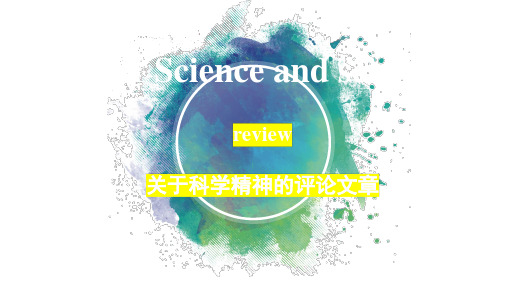
姓名 李四光ຫໍສະໝຸດ 出生头衔 中国地质学之父
1889年出生于湖北
1.1913 年 10 月,他在伯明翰大学接受高等教育,在那里 主要 他掌握了英语。
经历
2.1920年代任教于北京大学,对中国的能源、地震等进 行了大量的研究,不幸于1971年4月29日病逝
求真务实的科学精神和创新的思维给我们留下了深刻的 评价
印象,他对中国建设的伟大贡献将永远被人们铭记
Born in 1889 in Hubei Province, Li Siguang is called the Father of Geology in China.
In October, 1913 he received advanced education in the University of Birmingham, where he mastered English. In the 1920s, he taught in Beijing University. As a great scientist, he made lots of research on China’s energy, earthquakes, etc.
Scientific Spirit
title(头衔)
Brief introduction birthplace
image etc.
Personal experience and achievements
background education big events etc.
Evaluation
impact what you learn
祝你学业有成
2024年5月3日星期五11时35分13秒
《高科技英语讲》课件
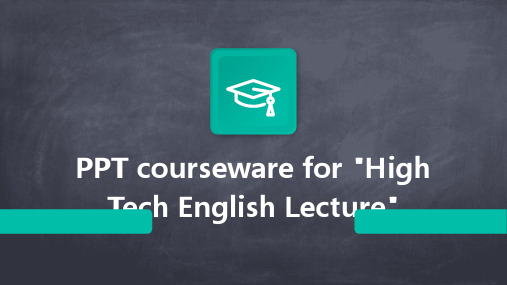
Skimming and Scanning
02
Use skimming and scanning techniques to quickly find
specific information in the text.
Contextual Understanding
03
Understand the context of the article, including the
background, current situation, and future trends.
Analysis of article structure
Organization and Layout
Identify the organizational structure of the article, including the introduction, body, and conclusion.
Complex Sentence Structure
High Tech English often requires the use of complex sentence structures to convey detailed information and technical concepts. Long sentences with multiple subordinate clauses are common.
如HTML、CSS、 JavaScript、Python 等。
Biotechnology English Vocabulary
基因与遗传词汇
如DNA、RNA、 gene、mutation等 。
生物技术词汇
如PCR、 transfection、 cloning等。
Unit 1 Science and scientist课件-高二上学期英语人教版选择性必修第二册
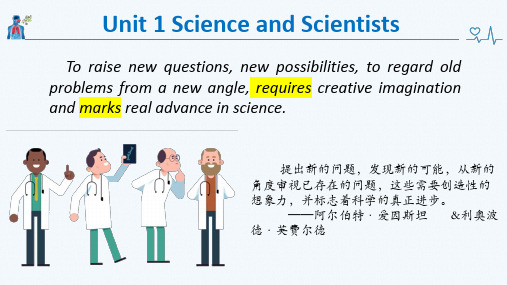
conclusion D The pump water
carried_c_h_o_le_r_a__g_e_rm__s.
E Snow had the_h_a_n_d_l_e_ of the pump removed. solution
Research method
Para.4& 5:Read for detailed information
Fast-reading
What's the main idea of the text?
A.The cause of cholera was polluted water. B.John Snow was a well-known doctor in London. C.The source of all drinking water should be examined. D.John Snow did some research and helped to solve “King Cholera”.
Stage 1
find a problem
contradictory
Para.2
proof
subscribe to
to agree with or support an opinion, a theory, etc.
Para.2 & 3:Find the seven stages
Stage 2 ask a question
mark
Para.3
exact
Para.2 & 3:Find the seven stages
Stage 4 collect data
Para.3
Para.2 & 3:Find the seven stages
《科技英语阅读》课件
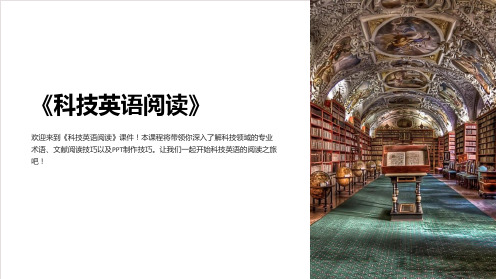
欢迎来到《科技英语阅读》课件!本课程将带领你深入了解科技领域的专业 术语、文献阅读技巧以及PPT制作技巧。让我们一起开始科技英语的阅读之旅 吧!
课程概述
课程目的
掌握科技领域的英语阅读能 力,提升专业素养。
课程容
科技专业词汇解析、文献阅 读技巧、PPT制作技巧、案例 分析等。
学习方法
PPT制作技巧
布局设计
探讨如何设计吸引人的PPT页面 布局。
资料搜集
介绍如何高效获取科技英语资 料和研究文献。
图文搭配
讨论如何有效地在PPT中使用图 像和文字来传达信息。
案例分析
绿色能源技术: 分析绿色能源技术的发展和应用,探讨环保与可持续发展。 人工智能应用: 介绍人工智能在科技领域的创新应用和未来发展趋势。 生物工程领域: 探索生物工程在农业、医疗和环境保护等方面的关键应用。
总结与展望
课程回顾: 回顾课程主要内容和学习成果,确保知识的掌握。 接下来的学习计划: 提供后续学习计划,帮助进一步拓展科技英语阅读能力。 学习成果展示: 学员有机会展示他们在课程中实践的成果和收获。
参考资料
文献链接: 提供科技英语阅读相关领域的优质文献链接,供学员参考。 词汇表: 整理科技英语专业词汇表,方便学员查阅和记忆。 PPT模板: 分享精美的PPT模板,帮助学员制作专业而美观的演示文稿。
通过实践、讨论和案例学习, 提高科技英语阅读能力。
科技专业词汇解析
词根、词缀: 深入探讨科技英语中常见的词根、词缀及其词意,帮助理解复杂术语。 常用词汇: 介绍科技领域中常用的英语词汇,扩充专业词汇量。
文献阅读技巧讲解
摘要阅读方法: 教授阅读科技文献摘要的技巧和要点,帮助快速获取文献核心信息。 正文阅读方法: 分享科技英语阅读技巧,提升阅读理解和分析能力。
《英语科技文阅读》课件
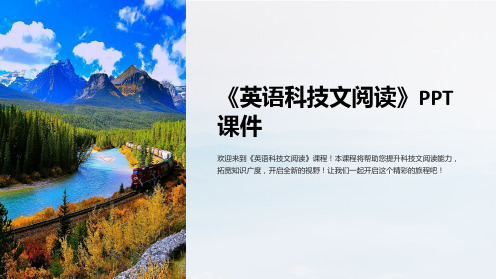
欢迎来到《英语科技文阅读》课程!本课程将帮助您提升科技文阅读能力, 拓宽知识广度,开启全新的视野!让我们一起开启这个精彩的旅程吧!
课程介绍
本节将介绍《英语科技文阅读》课程中所包含的内容和学习目标,帮助您了 解课程大纲,为接下来的学习做好准备。
英语科技文阅读的重要性
掌握英语科技文阅读能力是在当今科技发展快速的时代中提升个人竞争力的 关键所在。本节将探讨为什么英语科技文阅读对个人和职业发展如此重要。
关键词和术语
在掌握英语科技文阅读的过程中,了解并掌握相关的关键词和术语是非常重 要的。本节将带您了解一些常用的关键词和术语,并解释其在科技文阅读中 的含义。
文本类型和结构
科技文本多种多样,具有不同的结构和表达方式。本节将介绍常见的科技文本类型和结构,帮助您更好地理解 和解析科技文本。
阅读策略和技巧
掌握有效的阅读策略和技巧可以帮助您更高效地理解和ቤተ መጻሕፍቲ ባይዱ收科技文本的内容。 本节将分享一些实用的阅读策略和技巧,助您成为高效的科技文阅读者。
案例分析
通过深入分析和讨论真实的科技文献案例,您将有机会运用所学的技巧和策略,提升您的科技文阅读能力。本 节将带您一起探索不同领域的科技文献案例。
课程总结和展望
在本节中,我们将回顾本课程的重点内容,并为您展望未来的学习和发展方向。同时,我们也将分享一些学习 资源和工具,帮助您不断深化和提升英语科技文阅读能力。
《科技英语阅读》课件
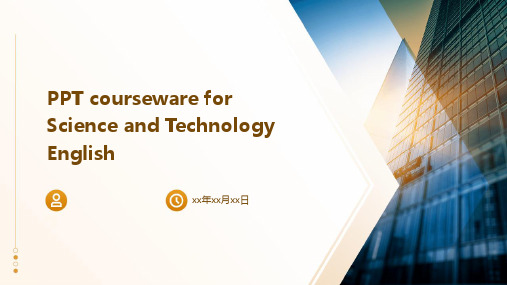
By analyzing complex English texts, students will improve their language comprehension and critical thinking abilities
Expand knowledge in science and technology
要点二
Roots and affixes method
Teach students to use knowledge of word construction such as roots and affixes to infer the meaning of new words and improve their reading comprehension ability.
要点三
Learning in context
Placing vocabulary in specific contexts, understanding the meaning of vocabulary through context, and deepening memory.
New vocabulary learning and memory methods
Reading comprehension skills
Summarizing
Summarizing is the skill of condensing a passage into a brief overview that captures its main points It helps in retaining important information and understanding the overall message of the text
科技英语阅读精选课件-新版.ppt
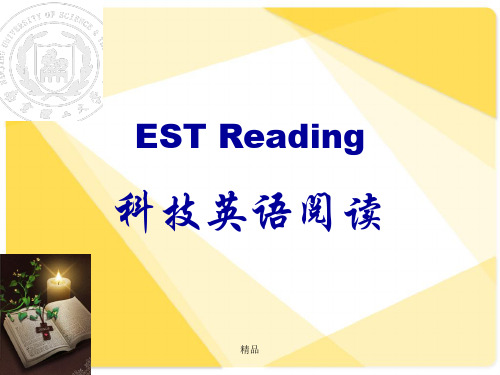
① Objectivity (客观性) 试比较:描写大海(文学作品) Break, break, break, On thy cold grey stones, O sea! And I would that my tongue could utter The thought that arise in me. ---- A. Tennyson
(可能产生歧义) --将在会上讨论的计划,是有很多问题的。 --关于这计划,有许多问题要在会上讨论。
精品
② Clarity (明确性)
How to
rewrite?
There are many problems concerning the
project to be discussed at the meeting.
EST Reading
科技英语阅读
精品
Contents
1.科技英语的主要特点 2.科技、半科技专业术语 3.科技英语中的复合词与专有名词 4. 科技英语中的复数形式与缩略语 5. 科技英语的主要句型 6.科技英语篇章阅读方法
精品
1. Main Features of EST
科技英语的主要特点
精品
Main Features:
① Objectivity (客观性) ② Clarity (明确性) ③ Accuracy (准确性) ④ Formality (正式性)
精品
Main Features:
① Objectivity (客观性) ② Clarity (明确性) ③ Accuracy (准确性) ④ Formality (正式性)
精品
① Objectivity (客观性)
文学作品:描写生动,文字优美,而 内容大都是人们曾经有过的经历或类似 情况,人们读了之后会产生共鸣,而加 以欣赏。 科技文章:传授知识,提供不具备或 者是不全面具备的新的科技内容,因而 着重文章的科学性、事实性和客观性, 体现科学工作者的非主观的科学态度。
高中英语课教案阅读和理解科技类文章
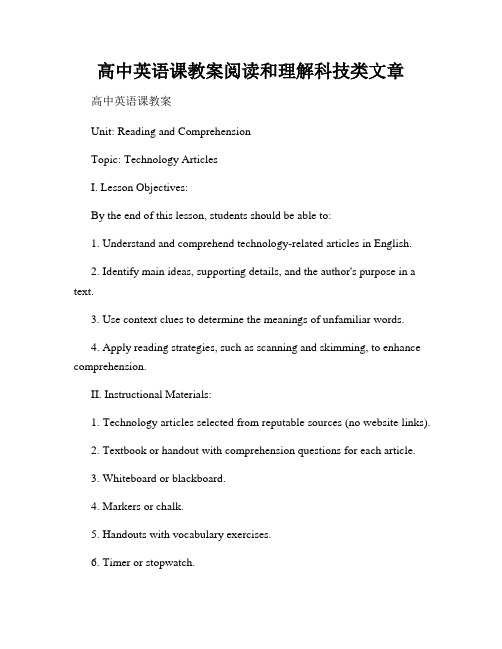
高中英语课教案阅读和理解科技类文章高中英语课教案Unit: Reading and ComprehensionTopic: Technology ArticlesI. Lesson Objectives:By the end of this lesson, students should be able to:1. Understand and comprehend technology-related articles in English.2. Identify main ideas, supporting details, and the author's purpose in a text.3. Use context clues to determine the meanings of unfamiliar words.4. Apply reading strategies, such as scanning and skimming, to enhance comprehension.II. Instructional Materials:1. Technology articles selected from reputable sources (no website links).2. Textbook or handout with comprehension questions for each article.3. Whiteboard or blackboard.4. Markers or chalk.5. Handouts with vocabulary exercises.6. Timer or stopwatch.III. Warm-up (5 minutes):1. Greet the students and engage in a brief class discussion about technology. Ask questions like:- What are some technological advancements you've recently heard about?- How has technology impacted different aspects of our lives?- Do you enjoy reading articles about technology? Why or why not?2. Ask students to share any interesting articles they have read or heard about recently.IV. Pre-Reading Activity (10 minutes):1. Introduce the topic of the day by displaying the selected technology article on the board.2. Elicit any background knowledge or prior experiences students may have related to the topic.3. Write a few key vocabulary words from the article on the board and discuss their meanings as a class.4. Distribute handouts with vocabulary exercises and have students complete them individually or in pairs.V. Reading Activity (20 minutes):1. Divide the students into pairs or small groups.2. Distribute the selected technology articles and comprehension questions.3. Instruct students to read the articles silently and underline or highlight any unfamiliar words.4. Encourage students to use context clues to guess the meanings of the unfamiliar words.5. Set a time limit and have students discuss the comprehension questions within their groups.VI. Post-Reading Activity (15 minutes):1. Conduct a whole-class discussion to check comprehension and answers to the comprehension questions.2. Encourage students to share their opinions on the topic of the article and any personal connections they made.3. Reinforce the main ideas and key details of the article by summarizing them as a class.VII. Follow-up Activities (10 minutes):1. Assign students to individually write a short summary of the article they read.2. Collect the summaries for assessment purposes.3. Engage students in a vocabulary review activity, such as a matching game or a quiz.VIII. Closure (5 minutes):1. Recap the main points discussed during the lesson.2. Ask students to reflect on what they learned about reading and comprehending technology articles.IX. Homework:1. Assign additional technology articles for students to read and write summaries on.2. Encourage students to explore reputable sources of technology news outside of class.Note: The above lesson plan is just a guideline. Teachers can modify or enhance it based on their students' needs and the available resources.。
高一英语 Unit 16《Scientists at work》Reading说课稿
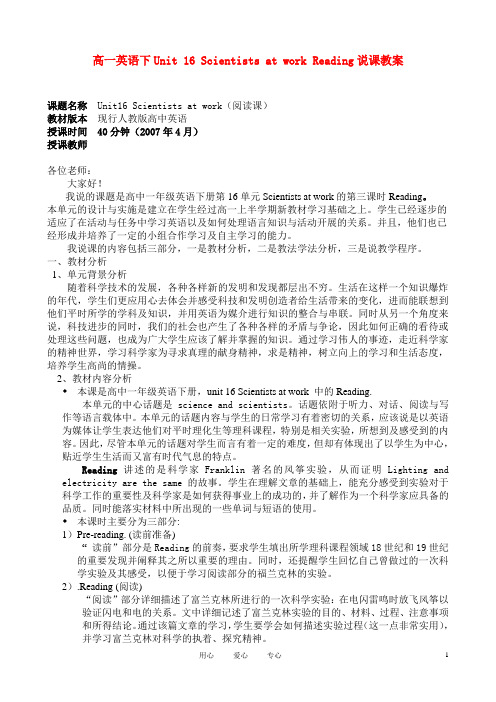
高一英语下Unit 16 Scientists at work Reading说课教案课题名称Unit16 Scientists at work(阅读课)教材版本现行人教版高中英语授课时间 40分钟(2007年4月)授课教师各位老师:大家好!我说的课题是高中一年级英语下册第16单元Scientists at work的第三课时Reading。
本单元的设计与实施是建立在学生经过高一上半学期新教材学习基础之上。
学生已经逐步的适应了在活动与任务中学习英语以及如何处理语言知识与活动开展的关系。
并且,他们也已经形成并培养了一定的小组合作学习及自主学习的能力。
我说课的内容包括三部分,一是教材分析,二是教法学法分析,三是说教学程序。
一、教材分析1、单元背景分析随着科学技术的发展,各种各样新的发明和发现都层出不穷。
生活在这样一个知识爆炸的年代,学生们更应用心去体会并感受科技和发明创造者给生活带来的变化,进而能联想到他们平时所学的学科及知识,并用英语为媒介进行知识的整合与串联。
同时从另一个角度来说,科技进步的同时,我们的社会也产生了各种各样的矛盾与争论,因此如何正确的看待或处理这些问题,也成为广大学生应该了解并掌握的知识。
通过学习伟人的事迹,走近科学家的精神世界,学习科学家为寻求真理的献身精神,求是精神,树立向上的学习和生活态度,培养学生高尚的情操。
2、教材内容分析♦本课是高中一年级英语下册,unit 16 Scientists at work 中的Reading.本单元的中心话题是science and scientists。
话题依附于听力、对话、阅读与写作等语言载体中。
本单元的话题内容与学生的日常学习有着密切的关系,应该说是以英语为媒体让学生表达他们对平时理化生等理科课程,特别是相关实验,所想到及感受到的内容。
因此,尽管本单元的话题对学生而言有着一定的难度,但却有体现出了以学生为中心,贴近学生生活而又富有时代气息的特点。
人教版高一级英语课件 Scientists at work Reading
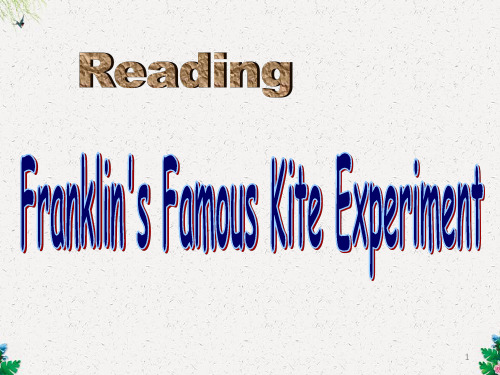
How did Franklin use his creativity to overcome various problems for his experiment?
1 We cannot go and look for lightning, so Franklin has to find a way to make lightning come to him: he attracted lightning using a kite.
8
6 He had to stop the kite from flying away, without touching the string that would be charged with electricity: he tied a silk ribbon to the string that he kept dry by standing inside the shed. Dry silk doesn’t conduct electricity, so it was safe to hold it in his hands.
9
7 He had to direct the electricity towards the condenser, with a piece of metal at the end of the string: he tied a metal key to the end of the string.
10
Retelling the story
Refer to the form of the science Report of Franklin’s kite, try to retell the story
Unit1ScienceandScientistsReadingandthinking课件高中英语选
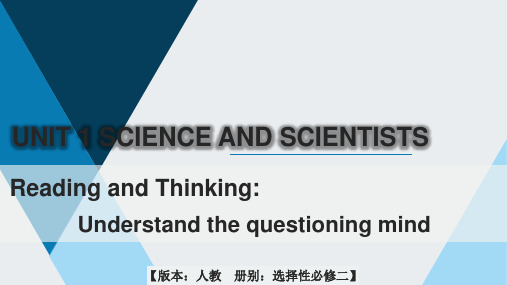
What will be talked about from the title ?
John Snow Defeats“King Cholera”
Who ?
How ? What ?
STAGES IN SCIENTIFIC RESEARCH
Draw a conclusion Collect data Analyse the results
Para. 3 Find supporting evidence & Draw a conclusion
Two deaths
Place In another part of London
Person A woman and her daughter
Event
Died of cholera because of drinking the water delivered from the pump
Think of a method Ask a question
Find supporting evidence Find a problem
Ⅱ While reading
Read the whole text quickly and match the main
ideas.
Para. 1
Snow began his study by marking on the map.
John Snow
John Snow became _f_r_u_s_tr_a_t_e_d__ because no one knew _h_o_w__t_o_p_r_e_v_e_n_t _o_r_t_re_a_t_c_h_o_l_e_r_a___.
a famous doctor
Unit1ScienceandScientistsReadingandThinking课件-高中英语
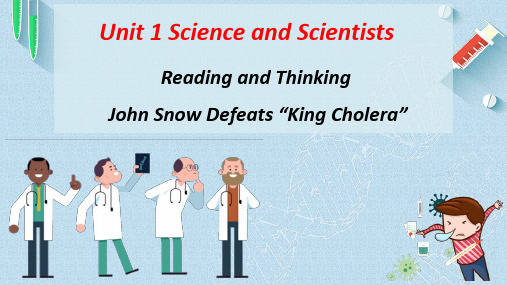
Add Something At Here
Add Something At Here
Add Something At Here
Add Something At Here
Cholera
loss of liquid (缺水) severe vomiting (呕吐) diarrhea (腹泻)
process
B Snow _m__a_r_ke_d__o_n_ _a__m_a__p_the places where people who _d_i_e_d_ had lived.
evidence C Many deaths occurred
near the _w_a_t_e_r_p_u_m__p in Broad Street.
It begins in the stomach and a severe case can lead to death without immediate treatment.
Pre-reading John Snow Defeats “King Cholera”
Who ?
How ?
What ?
plague[pleɪɡ] (鼠疫)
②
④
Ebola [ɪˈbəʊlə] (埃博拉
Tu Youyou followed the scientific stages to find out the cure for malaria. Can you put them in the right order?
What method did Snow use?
NAo dmeaatph hoafppBernoedahderSet. reet-”Cholera Map”
Unit1ScienceandScientistsReadingandThinking课件-高中英语
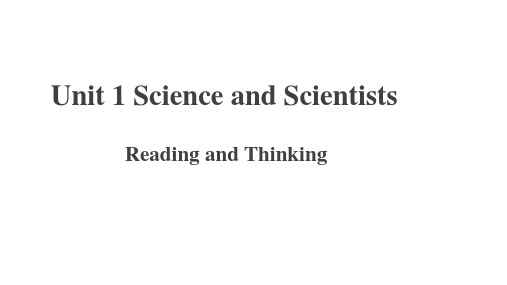
Pre-reading
Discuss the following stages of scientific research and then put them in the right order.
__5__ analyse the results __2__ ask a question __7__ draw a conclusion __4__ collect data __1__ find a problem __6__ find supporting evidence __3__ think of a method
Think of a method
Ask a question Collect data
Analyse the results Find supporting evidence
Draw a conclusion
Para 5 Snow’s contributions to preventing cholera
Snow began by __m_a_r_k_i_n_g_ on a map the exact places __w_h_e_r_e_ all those who died had lived. From the collected data, he _s_u_s_p_e_c_t_ed_ that the water pump was _to__b_l_a_m_e_. As a result of more _s_u_p_p_o_r_t_in_g_ evidence, he was able to announce that the pump water _c_a_r_r_ie_d_ cholera germs. Accordingly, he had the handle of the pump _r_em__o_v_e_d_. Through this intervention, the disease was stopped in its _t_r_a_c_k_.
Unit1ScienceandScientistsReadingandThinking课件-高中英语
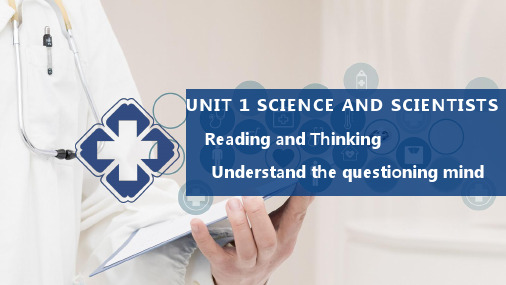
03 Careful-reading
Read para.1 quickly and fill in the mind map.
John Snow
Who? A British doctor who even attend to __Q__u_e__e__n__V__i_c_t_o__r_i_a
when she gave birth.
Collect results
Analyse the results
Ask a question
Find a problem Find supporting evidence
Page2 activity1
Can you put them in order and translate them into Chinese ?
04 Post-reading
1.How did John Snow find out the cause of the
Stage 7 draw a conclusion
Para.3
announce
As a result of this evidence...
TfCianosikmsh2p.alectteRiveaitacydti3vPiatoyrna3.P2aaangnded34.3ocnarPe3f.ully and
A. It was believed that cholera was caused by _b_a__d__a_iror germs in _fo__o_d___o_r__w__a_t_e.r
B. Snow began by __m__a_r_k_i_n__g__ _o_n__t_h__e__m__a_p____ the places where peopled_i_e_d___h_a_d__l_i_v_e. d
Unit1ScienceandScientistReadingandThinking课件高中英语人教
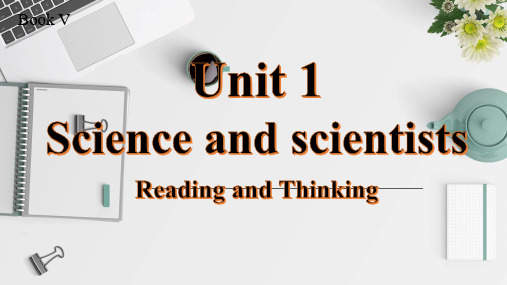
Learning aims
1.To learn how John Snow defeats “King Cholera” 2.To learn how to protect ourselves from cholera 3.To learn some good qualities from John Snow
Fast Reading
Para1 Para 2 Para 3 Para 4 Para 5
John began his study by marking on the map & the process.
He needed to prove the second theory was correct.
evidence
conclusion
C: Many deaths occurred near the w__a_oad Street.
D: The pump water carried c_h_o_l_e_ra__g_er_m_.s
Some people ___h_a_d_n_’_t __ drunk the water from the pump, and lived.
John Snow made great contributions to modern epidemiology.
John Snow want to use his knowledge to solve colera. He finally found out that dirty water was the cause of cholera.
Post reading 1.What should we do to avoid been infected?
高中英语阅读理解之科普知识类课件

2. What can a Jibo robot do according to Paragraph 3? A. Communicate with you and perform operations. B. Answer your questions and make requests. C. Take your family pictures and deliver milk. D. Obey your orders and remind you to take pills.
Finish Passage B in 8 minutes.
What’s the main idea of Passage B?
Para 1:City transformer is ready to shake up the auto
industry with their invention.
震动
4. How does Itamar Meridor feel about the future of the car?
A. Uncertain.
B. Hopeful.
C. Concerned.
D. Doubtful.
The last paragrahp: “To bring something like that as a solution for cities when so many people around the world are stuck in traffic jams, this is going to be something that I think can really change the experience of drivers,” said project manager Itamar Meridor.
- 1、下载文档前请自行甄别文档内容的完整性,平台不提供额外的编辑、内容补充、找答案等附加服务。
- 2、"仅部分预览"的文档,不可在线预览部分如存在完整性等问题,可反馈申请退款(可完整预览的文档不适用该条件!)。
- 3、如文档侵犯您的权益,请联系客服反馈,我们会尽快为您处理(人工客服工作时间:9:00-18:30)。
The main idea of Text A
• Socioeconomic Impact
Abusing ecosystem caused so much problems include collapsing fisheries, coastal “dead zones”, diseases, food. The Millennium Ecosystem Assessment gives us some arguments for respecting and consuming the Earth’s life-support systems. So we can reduce socioeconomic problems, such as hunger and poverty by changing the way we treat Earth’s environment.
展目标。这些目标包括消除赤贫、降低儿童死亡率、抗
击艾滋等疾病、发展全球伙伴关系等等。
3
The expansion of text
The Millennium Development Goals (MDGs) were developed out of the eight chapters of the United Nations Millennium Declaration, signed in September 2000. The eight goals include:
Nations member states and at least 23 international
organizations have agreed to achieve by the year
2015. They include halving extreme poverty, reducing
Combat HIV/AIDS, malaria, and other diseases
抗击艾滋病、疟疾和其他疾病
Promote gender equality and empower women 促进性别平等,为妇女赋 权
Ensure environmental sustainability 确保环境的可持续性
Reduce child mortality 降低儿童死亡率
Develop a global partnership for development 建立全球发展合作伙伴关 系
4
Exercises
1.What does the author mean by “many of the planet’s ecosystems are simply not making the grade”?
5
Exercises
3.What is the overall attitude of the report concerning the future of the Earth?
It is “only by understanding the environment and how it works ,can we make the necessary decisions to protect it .only by valuing all our precious natural and human resources, can we hope to build a sustainable future .
千年发展目标于2000年9月《联合国千年宣言》的八章内容中提出,八个目标 包括:
Eradicate extreme poverty and hunger消除赤贫和饥饿
Improve maternal health
改善母亲的健康状况
Achieve universal primary education 实现全球基础教育
child mortality rates, fighting disease epidemics such
as AIDS, and developing a global partnership for
development.
千年发展目标(MDGs)是由189个联合国成员国和至
少23个国际组织共同制定的于2015年之前完成的国际发
2
பைடு நூலகம்
The expansion of text
The Millennium Development Goals (MDGs)
The Millennium Development Goals (MDGs) are eight
international development goals that 189 United
It means that ,many ecosystems of the earth did not reach the standard for human to live.
2.Why was the UN Millennium Ecosystem Assessment initiated?
Because they found that two-thirds of earth’s life -supporting ecosystems are being degraded by unsustainable use.
4. What functions do wetlands play in conserving the environment?
• Call for radical change
Form nature perspective, we should change our mind to promote the level of decision-making. In order to ease the strains, we are putting on the nature; government, business and civil society should cooperate together.
